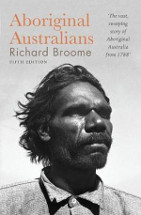Aboriginal Australians by Richard Broome

5th edition. Allen and Unwin, 2019. ISBN: 9781760528218.
This history of Aboriginal Australia from colonisation to the
present day looks at how our indigenous people have endured attempts
to erase their inconvenient presence through multiple programs to
assimilate or eradicate them. Reading it, as an immigrant, ignorant
Australian I have been appalled at the extent of systematic racial
discrimination over generations. Far from being a dry, academic tome
however, the author works through 15 focussed chapters using
interesting case studies and examples to support his analysis.
Colonialism infused the first encounters where "each was a dramatic
clash between Indigenous people who believed land was a spiritual
essence under their custodianship and was not transferrable, and
intruders who treated it as a valuable commodity to be exploited,
bought and sold" p37 including 1888 observations about "Social
Darwinism" p106 in which Europeans believed they were more highly
evolved. Assertions at Federation that Australia needed to "keep the
breed pure" p107, embroiled Aborigines in the White Australia
Policy, ultimately leading to the removal of children from their
families " a systematic, racially directed policy in an attempt to
erase Aboriginality and make Australia white" p200, The white man's
laws and ideas of justice brought to this country were imposed
universally including poaching laws which held property above life
until 1832 (p39) and there was (is) an ethnocentric bias as Mary
Durak observed in her 1959 book Kings in Grass Castles "no native
brought to justice in Kimberley was acquitted nor was any white
found guilty on a charge involving the treatment of an aborigine"
p114. Early missionaries brought Christian paternalism to people
they viewed as primitive savages and, apart from a few, well
presented exceptions "Aboriginal people on missions were generally
managed, protected, taught and chastised like children which eroded
their former autonomy." p153. Short summaries at the end of chapters
help to bring a perspective on specific issues, succinctly preparing
the reader for the next argument. Working through chapters on civil
rights, indigenous rights and aspirations for equality we are
brought up to the present day with chapter 14 "Crisis, intervention
and apology" and 15 'Seeking a voice" where we are suddenly thrust
from reading about past injustices to our own complicit involvement
in resisting acknowledgement of our nation's first people.
First published in 1982, the book has been fully revised and is in
its fifth edition, being reprinted 33 times. The author patiently
builds us a perspective on Aboriginal history, from the general to
the particular using statistics and individual accounts through well
referenced quotes. Nothing is sensationalised and strategic book
recommendations are offered to help readers educate themselves more
broadly. Extensive notes to each chapter make this a valuable
resource. It should be in every library and required reading for
every teacher and politician.
Sue Speck